Abstract
Background
Only a few patients who experience AML relapse derive lasting benefit from re-induction therapy. The utility of reassessing the disease karyotype at relapse is unclear. The main goals of this study were to identify prognostic factors for AML relapse and to determine the prognostic utility of karyotypic change between diagnosis and relapse as a variable for predicting response to salvage therapy for relapsed AML.
Methods
This retrospective study included 58 patients with relapsed AML treated at the Yonsei University College of Medicine between 2005 and 2010. Karyotypes at both diagnosis and relapse were available for 45 patients (77%). A change in karyotype at relapse was observed in 17 of 45 cases (37%), and no change was noted in 28 of 45 cases (62%).
Results
Karyotypic changes between diagnosis and relapse were associated with the response rate (RR) to salvage therapy (P=0.016). Overall survival (OS) and event-free survival (EFS) in the group with karyotypic changes between diagnosis and relapse were significantly different from those with no karyotypic changes (P=0.004 and P=0.010, respectively). We applied multiple multivariate Cox regression analyses to identify independent prognostic factors for overall response (OR), OS, and EFS. A change in karyotype between diagnosis and relapse was significantly associated with OS (P=0.023; RR=2.655) and EFS (P=0.033; RR=2.831).
Most AML patients who achieve a complete remission (CR) experience relapse within 3 years of the primary diagnosis. The prognosis of patients after relapse is generally poor [1], and there is no widely approved salvage regimen for AML relapse [2]. Prediction of prognosis at the time of relapse would therefore be useful. Important predictors of response to re-induction chemotherapy include duration of first remission; age at relapse; prior stem cell transplantation; and cytogenetic findings, especially chromosomal changes, at initial diagnosis [1]. Among patients who relapse, up to 90% with a favorable karyotype at diagnosis achieve secondary complete remission (CR2), whereas the CR2 rate can be as low as 36% among patients with adverse karyotypes at diagnosis [3]. Information regarding karyotype and remission rates is used to modify both the intensity and nature of salvage therapy.
Genomic instability may play a role in the development of resistance to anti-leukemic therapy. After relapse, leukemic cells are often refractory to standard chemotherapeutic agents, and consequently, more aggressive therapies are needed to treat this resistant disease [2]. Resistance to therapy in ALL patients may be affected by acquired additional karyotypic abnormalities in the leukemic cells during relapse [4]. Although some studies have shown that karyotypic progression at AML relapse predicts a poor prognosis after salvage chemotherapy [5], the utility of reassessing the karyotype at relapse is unclear.
In this study, we reviewed the data of 58 patients with relapsed AML who received salvage therapy. The main goals of this study were to identify prognostic factors for relapsed AML and to provide evidence for the prognostic utility of karyotypic changes between diagnosis and relapse as a variable for predicting response to salvage therapy for relapsed AML.
Fifty-eight adult patients with relapsed AML treated at the Division of Hematology, Severance Hospital, Yonsei University College of Medicine, between January 2005 and December 2010 were included in this study. Written informed consent was obtained from each patient. Diagnosis of AML was established on the basis of bone marrow (BM) aspiration findings. AML was classified according to the morphological French-American-British (FAB) criteria, and the diagnosis was confirmed on the basis of cytochemical and immunological analyses findings [6]. At diagnosis and relapse, samples of BM or blood were examined for cytogenetic abnormalities using standard banding techniques and were classified according to the International System for Human Cytogenetic Nomenclature [7]. Cytogenetic analysis was successfully performed for 54 of 58 patients (93%) at diagnosis and for 48 of 58 patients (82%) at relapse. Karyotypes were classified as favorable (t(8;21), chromosome 16 abnormalities), adverse (complex karyotype, -7, 3q abnormality, del(5q), -5, 11q23), or intermediate (no abnormality, +8, +21, del(7q), del(9q), +22, with other numerical and structural abnormalities) according to the MRC AML 10 study [8]. Induction therapy with idarubicin (IDA) (12 mg/m2/d intravenous [IV] over 30 min on days 1.3) in combination with cytosine arabinoside (Ara-C) (100 mg/m2/d IV continuous infusion on days 1.7) was administered to all patients, except for 1, who received mitoxantrone, etoposide, and cytarabine (MEC)-based chemotherapy (mitoxantrone, 12 mg/m2/day on days 1.4; etoposide, 100 mg/m2/day on days 1.3; and Ara-C, 1,000 mg/m2/12 hr on days 1.3). As salvage therapy, 40 patients received MEC-based chemotherapy with or without gemtuzumab ozogamicin (GO) (90 mg/m2 on day 4), 13 patients received other intensive combination chemotherapy (Ara-C, topotecan, and IDA, N=5; fludarabine, IDA, and Ara-C: N=4; IDA and Ara-C: N=2; and GO: N=1), and the remaining 5 patients received allogeneic hematopoietic stem cell transplantation (HCT). To determine the impact of salvage therapy on relapsed AML, patients were classified into prognosis subsets according to the new European Leukemic Net (ELN) recommendations, recently proposed by an expert panel [1].
CR was defined as normal cellular BM with normal erythroid and myeloid elements and less than 5% myeloblasts and normalization of peripheral blood counts (neutrophils >1×109/L and platelets >100×109/L). CR with incomplete platelet recovery (CRp) was defined according to the same criteria for CR but with additional platelet transfusion independence and platelet counts of <100×109/L. CR and CRp cases were considered in the computation of the overall response (OR). All other types of responses were considered as treatment failure. Relapse was defined as the detection of at least 5% leukemic blasts in BM aspirates or new extramedullary (EM) leukemia in patients with previously documented CR [9].
Descriptive statistics are reported as frequencies or medians and ranges. OR, overall survival (OS), and event-free survival (EFS) were the primary endpoints. The χ2 test was used to test for factors associated with OR. Survival was calculated from the date of the documentation of relapse until death or last follow-up for OS or until failure, relapse, death, or last follow-up for EFS. OS and EFS were estimated using the Kaplan-Meier product limit method. The following factors were analyzed for their association with OR, OS, and EFS: age at relapse, type of AML (de novo vs. secondary), EM involvement at diagnosis, cytogenetic findings at diagnosis and relapse, number of induction cycles of chemotherapy required to achieve the first CR, previous HCT, relapse-free interval (RFI), type of salvage regimen, and karyotypic changes between diagnosis and relapse. The relationships between patient and disease characteristics and clinical outcomes were evaluated using multivariate analysis. OR was analyzed using multivariate logistic regression analysis, and OS and EFS were analyzed using Cox's proportional hazard model. P values were two-tailed and considered statistically significant if <0.05. All factors associated with a P value of <0.20 in univariate analysis were entered into multivariate analyses. The final analysis was performed using SPSS Inc., 12.0 (Chicago, IL, USA).
Karyotype records at both diagnosis and relapse were available for 45 patients (77%). A change in karyotype was observed in 17 out of 45 cases (37%, group 1) and no change was noted in 28 out of 45 cases (62%, group 2). Karyotypic changes between diagnosis and relapse in group 1 are shown in Table 1. An intermediate karyotype at diagnosis changed to a complex karyotype at relapse in 8 cases (47%). Favorable karyotypes (2 cases of t(8;21) and 1 of inv(16)) at diagnosis changed to normal karyotypes at relapse in 2 cases and were the same aberrant karyotypes as at initial diagnosis but with additional aberrations at relapse in 1 case. Adverse karyotypes at diagnosis changed to complex karyotypes in 3 cases, and a translocation involving 11q23 changed to a normal karyotype in 1 case.
We enrolled 31 male and 27 female patients, with a median age at diagnosis of 49 years (range, 17.76 years) and a median follow-up duration from relapse of 14.3 months (range, 0.2-149.0 months). Patient characteristics of groups 1 and 2 are summarized in Table 2. In group 1, all patients had de novo AML, and AML was significantly more prevalent in group 1 than in group 2 (71.4%, P=0.016). The frequencies of cytogenetic changes at relapse were significantly different between the 2 groups (P<0.001), although both groups were comparable in terms of the karyotype classification, or the cytogenetic risk, at diagnosis. In group 1 at relapse, 1 patient (5.9%) had a favorable karyotype, 5 patients (29.4%) had an intermediate karyotype, and 11 patients (64.7%) had an unfavorable karyotype. In group 2, 3 patients (10.7%) had a favorable karyotype, 22 patients (78.5%) had an intermediate karyotype, and 3 patients (10.8%) had an unfavorable karyotype. In group 2, 23 (82%) patients received HCT before relapse, compared to only 5 patients (52.9%) in group 1 (P=0.036). Cut-off points for age and RFI were chosen on the basis of the mean values in all patients. The 2 groups did not show statistical differences in age (<49 vs. ≥49 years), sex, FAB classification, white blood cell count at diagnosis (<100 vs. ≥100×109/L), EM involvement at diagnosis, type of salvage therapy, number of induction cycles required to reach first CR and relapse, or RFI (<7.5 vs. ≥7.5 months).
Clinical, biological, and treatment-related data were analyzed to establish whether they had prognostic value with respect to OR, OS, and EFS. The OR (CR and mCR) rate was significantly lower in group 1 than in group 2 (23% vs. 38%; P=0.016). Univariate analysis showed that the cytogenetic risk at relapse (P=0.030) and the type of salvage therapy (P=0.039) were associated with OR (Table 3).
Fig. 1 shows Kaplan-Meier curves for OS and EFS. Patients in group 1 had a shorter median OS (14.2 vs. 21.1 months, P=0.004) and shorter median EFS (4.1 vs. 6.0 months, P=0.010) than those in group 2. Age at relapse (P=0.033) and type of salvage therapy (P=0.044) were significantly associated with OS, and the type of AML (de novo vs. secondary) (P=0.025) and cytogenetic risk group at relapse (P=0.028) were associated with EFS (Table 3). We also applied multiple multivariate Cox regression analyses to identify independent prognostic factors for OR, OS, and EFS. Karyotypic change between diagnosis and relapse was the only independent predictor of OS (P=0.023; response rate [RR]=2.655) and EFS (P=0.033; RR=0.033) that retained significance (Table 4).
In ALL, karyotypic changes at relapse are considered to have poor prognostic implications, such as a poor therapeutic response and shorter OS [10, 11]. However, only a few studies have investigated the implications of karyotypic changes in AML [5]. According to the new ELN prognosis subsets recently proposed by an expert panel [1], patients with early relapse (i.e., duration of first CR, <6 months), adverse cytogenetic findings at diagnosis, older age, or previous HCT are more likely to have a poor outcome, and, at present, the prognostic impact of karyotypic changes at relapse compared with the impact of the karyotype at diagnosis is not clear. In this study, we observed karyotypic changes in 17 of 45 (38%) patients, although karyotypic changes have been reported to occur in approximately 60% of AML patients [12]. No significant association was found between karyotypic change and RFI in this study, in contrast to the other findings [11]. In the present study, adverse karyotypes at relapse were more frequent in group 1 than in group 2, because the most common pattern of karyotypic change at relapse was the complex type that involved additional aberrations to those present at diagnosis. This finding is consistent with previous reports on AML [5]. In our study, HCT before relapse was more frequent in group 1 than in group 2 (52.9% vs. 82.1%, P=0.036). According to another report [13], karyotypic change, particularly clonal evolution, is common at relapse after allogeneic transplantation in acute leukemia patients.
In this study, we identified potential prognostic factors for relapsed AML patients using clinically relevant parameters. The karyotype is universally recognized as the best prognostic factor for AML [8, 14, 15]. This was confirmed by univariate analysis in our patients, for whom karyotypic grouping at relapse was the main prognostic factor in terms of OR and EFS rather than in terms of OS. However, multivariate analysis showed that karyotypic grouping at relapse was not associated with OR or EFS. Previously, RFI has been considered as the major prognostic determinant after relapse [16, 17]. We divided patients who showed first relapse into 3 groups according to length of RFI (<7.5 vs. ≥7.5 months) and compared OR, OS, and EFS. These results were similar to those of other studies. Other important clinically prognostic factors for relapsed AML are patient age at relapse and prior HCT history [1]. In our study, patients who were older at relapse (≥49 years) had a lower OS, but this trend did not prove to be significant in multivariate analysis. Karyotypic change between diagnosis and relapse was noted in 23% of cases, no change was noted in 48% of cases, and the remaining cases could not be evaluated. Karyotypic change between diagnosis and relapse significantly influenced OR (P=0.014), OS (P=0.004), and EFS (P=0.010). The importance of karyotypic changes for prognosis is further supported by a study showing that aberrations detected at relapse influence patient outcome to a greater extent than aberrations detected at diagnosis [5]. Most karyotypic changes at relapse were noted in cases that had been included in the intermediate karyotypic group at diagnosis and were of the complex type (unfavorable karyotypic group) at relapse. In cases with complex karyotypes at diagnosis, the karyotype at relapse was still complex (same aberrant karyotype plus additional aberrations at relapse and fewer but similar aberrations plus new aberrations at relapse compared to diagnosis).
In conclusion, despite its retrospective nature and the small number of patients, our study indicates that karyotypic change between diagnosis and relapse can be adapted to predict CR outcomes and tailor routine clinical and biological therapeutic strategies for relapsed AML patients.
References
1. Dohner H, Estey EH, Amadori S, et al. Diagnosis and management of acute myeloid leukemia in adults: recommendations from an international expert panel, on behalf of the European LeukemiaNet. Blood. 2010; 115:453–474. PMID: 19880497.
2. Craddock C, Tauro S, Moss P, Grimwade D. Biology and management of relapsed acute myeloid leukaemia. Br J Haematol. 2005; 129:18–34. PMID: 15801952.

3. Weltermann A, Fonatsch C, Haas OA, et al. Impact of cytogenetics on the prognosis of adults with de novo AML in first relapse. Leukemia. 2004; 18:293–302. PMID: 14671635.

4. Kawamata N, Ogawa S, Seeger K, et al. Molecular allelokaryotyping of relapsed pediatric acute lymphoblastic leukemia. Int J Oncol. 2009; 34:1603–1612. PMID: 19424578.

5. Kern W, Haferlach T, Schnittger S, Ludwig WD, Hiddemann W, Schoch C. Karyotype instability between diagnosis and relapse in 117 patients with acute myeloid leukemia: implications for resistance against therapy. Leukemia. 2002; 16:2084–2091. PMID: 12357361.

6. Bennett JM, Catovsky D, Daniel MT, et al. Proposed revised criteria for the classification of acute myeloid leukemia. A report of the French-American-British Cooperative Group. Ann Intern Med. 1985; 103:620–625. PMID: 3862359.
7. Mitelman F, editor. ISCN: Guidelines for cancer cytogenetics. Supplement to an international system for human cytogenetic nomenclature. 1991. Basel, Switzerland: Karger;p. 1–53.
8. Grimwade D, Walker H, Oliver F, et al. The Medical Research Council Adult and Children's Leukaemia Working Parties. The importance of diagnostic cytogenetics on outcome in AML: analysis of 1,612 patients entered into the MRC AML 10 trial. Blood. 1998; 92:2322–2333. PMID: 9746770.

9. Yates J, Glidewell O, Wiernik P, et al. Cytosine arabinoside with daunorubicin or adriamycin for therapy of acute myelocytic leukemia: a CALGB study. Blood. 1982; 60:454–462. PMID: 6953986.

10. Chucrallah AE, Stass SA, Huh YO, Albitar M, Kantarjian HM. Adult acute lymphoblastic leukemia at relapse. Cytogenetic, immunophenotypic, and molecular changes. Cancer. 1995; 76:985–991. PMID: 8625224.

11. Vora AJ, Potter AM, Anderson LM, Lilleyman JS. Frequency and importance of change in blast cell karyotype in relapsing childhood lymphoblastic leukemia. Pediatr Hematol Oncol. 1994; 11:379–386. PMID: 7947010.

12. Estey E, Keating MJ, Pierce S, Stass S. Change in karyotype between diagnosis and first relapse in acute myelogenous leukemia. Leukemia. 1995; 9:972–976. PMID: 7596187.
13. Schmidt-Hieber M, Blau IW, Richter G, et al. Cytogenetic studies in acute leukemia patients relapsing after allogeneic stem cell transplantation. Cancer Genet Cytogenet. 2010; 198:135–143. PMID: 20362228.

14. Schiffer CA, Lee EJ, Tomiyasu T, Wiernik PH, Testa JR. Prognostic impact of cytogenetic abnormalities in patients with de novo acute nonlymphocytic leukemia. Blood. 1989; 73:263–270. PMID: 2910364.

15. Keating MJ, Smith TL, Kantarjian H, et al. Cytogenetic pattern in acute myelogenous leukemia: a major reproducible determinant of outcome. Leukemia. 1988; 2:403–412. PMID: 3164797.
16. Kantarjian HM, Keating MJ, Walters RS, McCredie KB, Freireich EJ. The characteristics and outcome of patients with late relapse acute myelogenous leukemia. J Clin Oncol. 1988; 6:232–238. PMID: 3276823.

17. Mortimer J, Blinder MA, Schulman S, et al. Relapse of acute leukemia after marrow transplantation: natural history and results of subsequent therapy. J Clin Oncol. 1989; 7:50–57. PMID: 2642540.

Fig. 1
(A) OS in AML patients with and without karyotypic change between diagnosis and relapse. The 2 groups (P=0.004) showed significant differences in OS. (B) EFS in AML patients with and without karyotypic change between diagnosis and relapse. Karyotypic change was significantly associated with EFS after relapse (P=0.010). a)Cases with changed karyotypes between diagnosis and relapse; b)Cases without changed karyotypes between diagnosis and relapse. Abbreviations: AML, Acute myeloid leukemia; OS, overall survival; EFS, event-free survival.
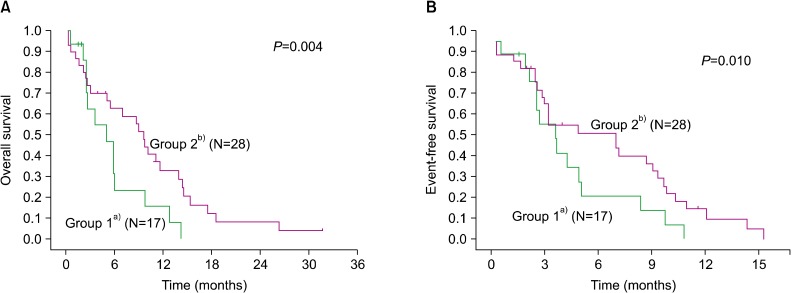
Table 2
Characteristics of patients according to karyotypic changes between diagnosis and relapse.
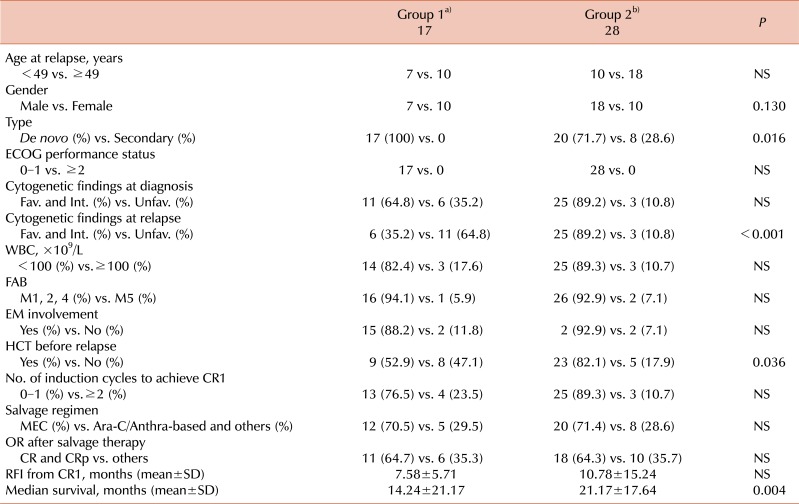
a)Cases with changed karyotypes between diagnosis and relapse; b)Cases with unchanged karyotypes between diagnosis and relapse.
Abbreviations: FAB, French-American-British classification; EM, extramedullary; WBC, white blood count; Fav., favorable; Int., intermediate; Unfav., unfavorable; No., number; OR, overall response; CR, complete response; CRp, CR with incomplete platelet recovery; HCT, hematopoietic stem cell transplantation; RFI, relapse-free interval; CR1, first complete response; SD, standard deviation; NS, not significant.




 PDF
PDF ePub
ePub Citation
Citation Print
Print


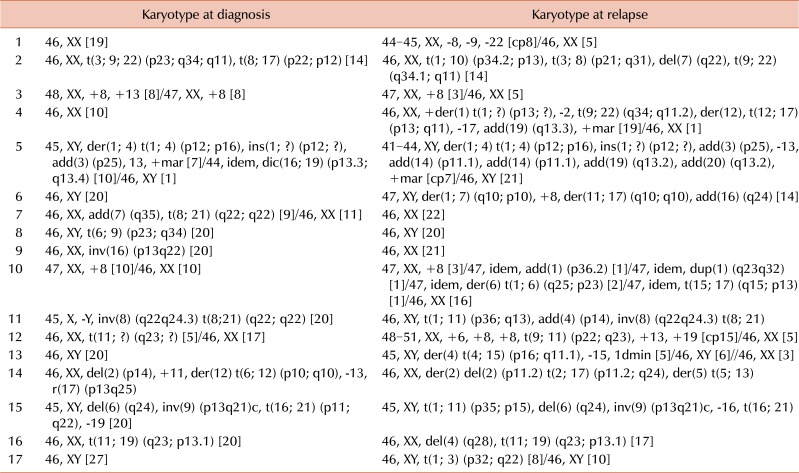
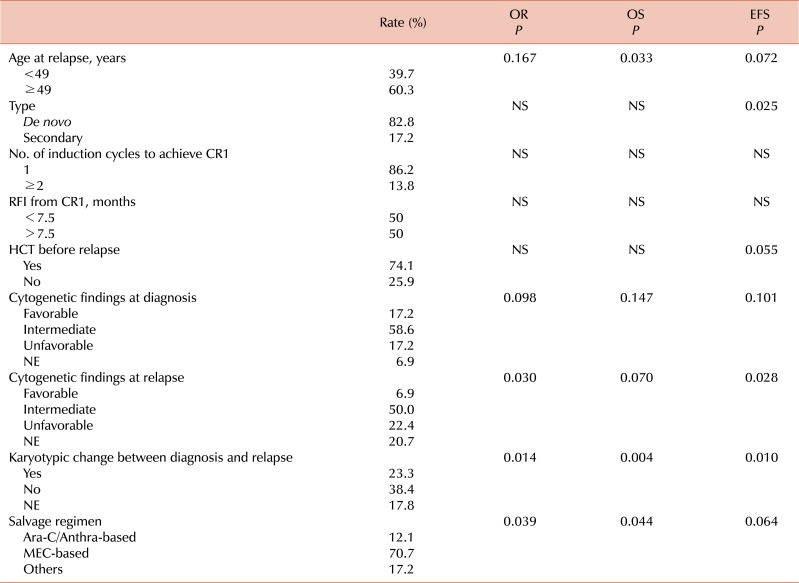
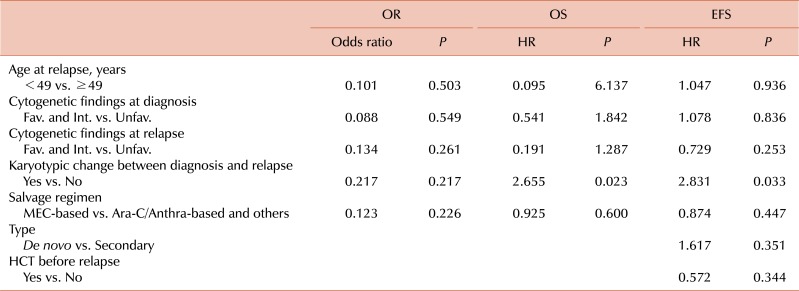
 XML Download
XML Download